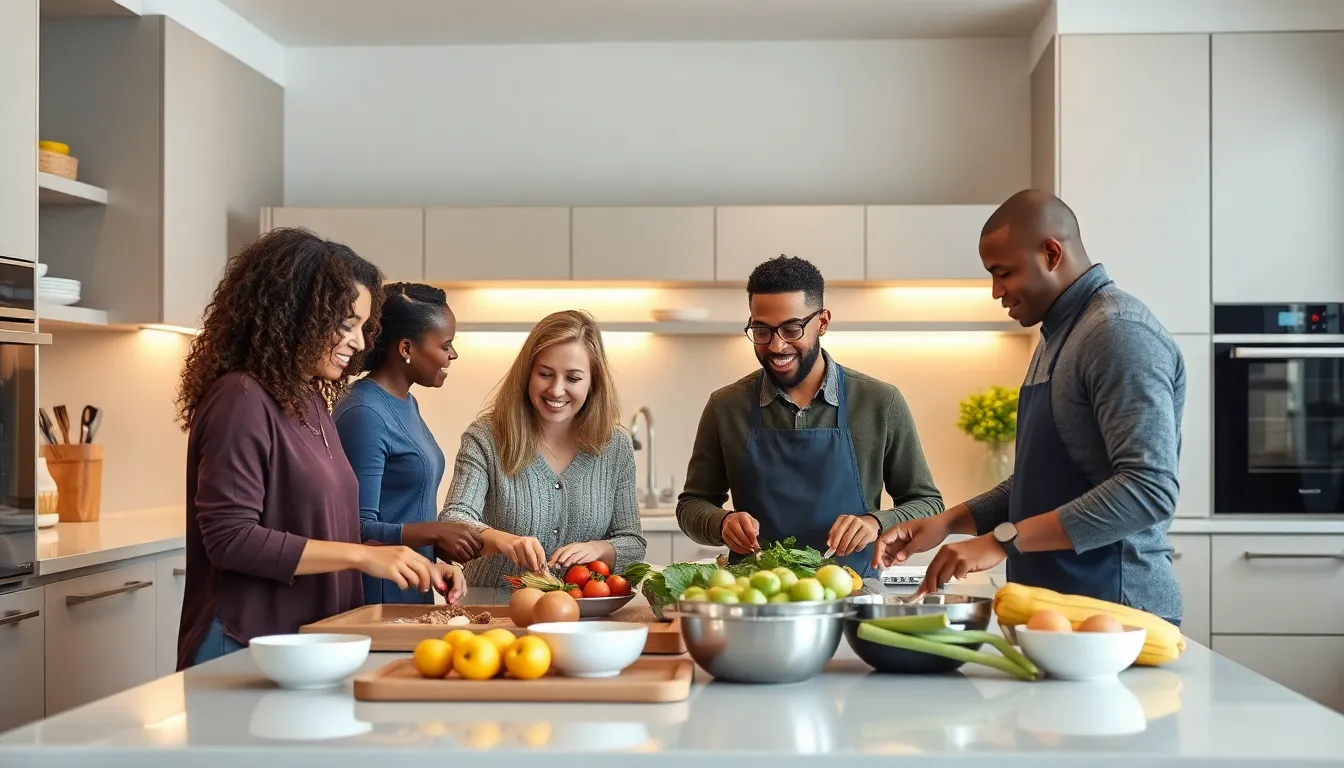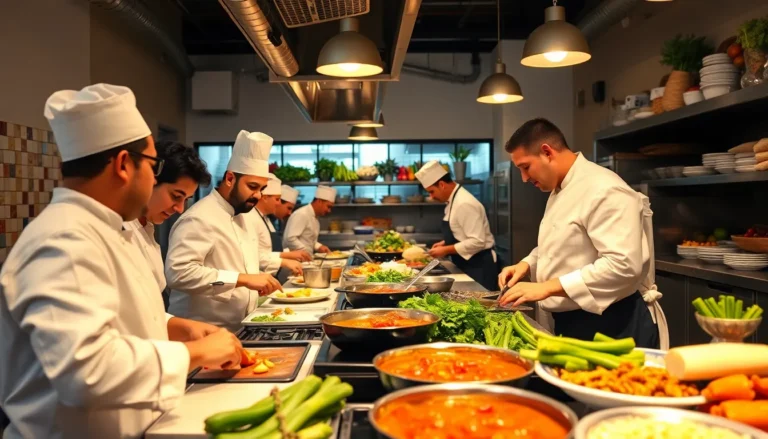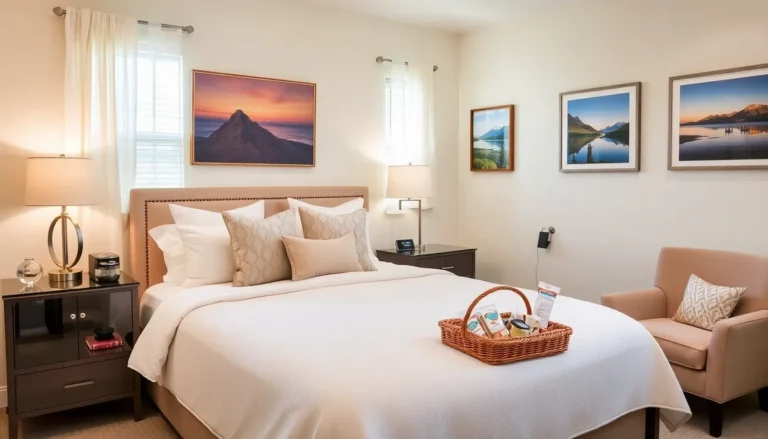Table of Contents
ToggleIn the world of kitchens, it’s not just about the latest gadgets or the trendiest color schemes. It’s about creating a space that truly understands its inhabitants. Enter human-centered kitchen design—a revolutionary approach that puts people at the heart of culinary creativity. Imagine a kitchen that knows you better than your best friend, anticipating your every need while making cooking feel like a breeze.
Overview of Kitchens Human Design
Kitchens developed through human-centered design prioritize functionality and user experience. This design philosophy puts the needs and preferences of users first, optimizing layouts and features for convenience. Focusing on workflows enhances cooking efficiency while minimizing unnecessary movements.
Ergonomics plays a crucial role in kitchen design. Counter heights accommodate various users, making food preparation more comfortable. Storage solutions are tailored to individual habits, ensuring frequently used items remain easily accessible.
The layout significantly impacts usability. Open designs encourage interaction among users, fostering a communal cooking atmosphere. Zones within the kitchen, such as prep, cooking, and cleaning areas, enhance flow and organization.
Materials and colors can influence the kitchen environment. Warm tones may promote a welcoming atmosphere, while durable materials withstand everyday use. Incorporating natural light contributes to a pleasant ambiance, improving overall functionality.
Technology integration offers added benefits in modern kitchens. Smart appliances simplify tasks, from cooking to cleaning, by allowing remote control and monitoring. Additionally, energy-efficient designs align with sustainability goals, reducing the environmental impact.
Personalization ensures that kitchens meet unique user needs. Custom cabinetry can reflect style preferences while maximizing space. Lighting options can cater to different tasks, making cooking safe and efficient during various times of day.
Understanding kitchens through human design creates environments that are not only visually appealing but also highly functional. This approach transforms the culinary experience, making it intuitive, enjoyable, and deeply connected to users’ lifestyles.
Key Principles of Human-Centered Design

Human-centered design prioritizes the needs of individuals in kitchen spaces. This approach focuses on creating environments that enhance the cooking experience while promoting usability and comfort.
User Needs and Preferences
Recognizing user needs shapes kitchen design. Understanding how people cook, socialize, and interact in this space allows for tailored features. Custom cabinetry and adjustable shelving accommodate diverse preferences. Individuals benefit from storage solutions placed close to commonly used items, easing the cooking process. Lighting options can adapt to different culinary tasks, providing the right ambiance while ensuring functionality. Personalization fosters a deeper connection to the kitchen environment, making it a place where creativity thrives and efficiency reigns.
Ergonomics and Spatial Layout
Ergonomics plays a vital role in kitchen design, enhancing user comfort. Optimal counter heights facilitate ease of use for individuals of varying statures. Workflow efficiency is achieved through strategic layouts that create designated zones for cooking, prepping, and cleaning. These zones promote a smooth flow, reducing unnecessary movement during meal preparation. Open designs encourage collaboration, inviting family and friends to share in the cooking experience. Materials selected for durability and aesthetics complete the design, ensuring that the kitchen withstands daily use while remaining visually appealing.
Elements of Effective Kitchen Design
Effective kitchen design combines functionality and aesthetics, ensuring a harmonious cooking space that enhances user experience. Focusing on individual needs contributes to greater usability and overall satisfaction.
Workflow and Efficiency
An efficient kitchen layout optimizes workflow by creating defined zones for cooking, prep, and cleaning. Streamlined paths reduce unnecessary movements, allowing for quick transitions between tasks. Placing frequently used items within reach simplifies access, saving time during meal preparation. Ergonomic counter heights accommodate all users, ensuring comfort during longer cooking sessions. Thoughtful design choices boost productivity, fostering a more enjoyable cooking experience.
Aesthetic Considerations
Visual appeal plays a significant role in kitchen design, with cohesive color schemes and materials creating a welcoming atmosphere. Warm tones set a friendly environment, while durable surfaces withstand daily wear. Lighting options, such as pendant lights or under-cabinet fixtures, enhance functionality and elevate style. Personal touches, like custom cabinetry and decorative accents, reflect the user’s personality. Balancing beauty with practicality ensures the kitchen remains both inviting and efficient.
Case Studies in Kitchens Human Design
Case studies illustrate the effectiveness of human-centered kitchen design across various environments. A prominent example comes from a Seattle-based family that transformed their outdated kitchen into a space optimized for both functionality and social interaction. By incorporating an open layout with designated zones for prep, cooking, and cleaning, they significantly improved workflow.
Another case shows a restaurant in Chicago that utilized ergonomic principles to enhance efficiency. By adjusting counter heights and ensuring easy access to tools, chefs reported less fatigue during busy service hours. Storage solutions tailored to frequently used items further streamlined their operations, demonstrating the practical benefits of thoughtful design in a high-paced environment.
In a suburban home in Denver, customization played a pivotal role. The homeowners collaborated with designers to create cabinetry that reflected their individual styles while maintaining practical storage needs. This personal touch not only contributed to aesthetics but also ensured that the kitchen remained highly functional.
Another notable project occurred in a small apartment in New York City, where space was at a premium. Creative use of materials and color choices established a warm atmosphere despite the limited square footage. Incorporation of natural light through strategically placed windows made the kitchen feel larger and more inviting, showcasing the importance of light in design.
Lastly, a modern kitchen in a sustainable home in Portland highlights technology integration. Smart appliances simplified meal preparation, aligning with energy efficiency goals. The kitchen’s layout encouraged family interaction, reinforcing the idea that human-centered design enhances both function and personal connection.
These examples reveal how thoughtful design choices create kitchens that cater to the needs and lifestyles of their users, making culinary experiences enjoyable and intuitive.
Future Trends in Kitchen Design
User-centric innovations shape modern kitchen design. Integration of smart appliances elevates functionality. Smart stovetops precisely adjust temperatures, enhancing cooking precision. Voice-activated assistants streamline meal prep, providing hands-free convenience. Energy-efficient appliances align with sustainability standards, minimizing environmental impact.
Ergonomics play a crucial role in future trends. Countertops designed for standing or seated use accommodate diverse needs. Custom cabinetry incorporates pull-out shelves, ensuring easy access to essentials. Adjustable shelving adapts to various items, enhancing organization and minimizing clutter.
Sustainable materials define the essence of modern kitchens. Recycled surfaces and eco-friendly finishes prioritize environmental responsibility. Natural wood and stone bring warmth to design, creating inviting atmospheres. Incorporation of plants enhances both aesthetics and air quality, fostering a healthy environment.
Open layouts promote interaction among users. Flexible kitchen islands serve as multi-functional spaces for cooking and socializing. Zoning strategies enhance workflow, delineating areas for preparation, cooking, and cleanup. These distinct zones facilitate collaboration, making the kitchen a communal hub.
Color trends shift towards muted and earth-toned palettes. Warm hues encourage relaxation, fostering an enjoyable cooking atmosphere. Accent colors provide personalization, allowing users to express their style. Thoughtful lighting complements colors, highlighting design elements while ensuring adequate visibility.
Technology’s evolution continues to influence kitchen design. Apps for meal planning and grocery shopping streamline everyday tasks. Virtual reality tools assist in layout planning, providing immersive design experiences. These advancements empower users to create kitchens tailored to their individual lifestyles.
Overall, future trends in kitchen design emphasize user needs, sustainability, and technology integration. Engaging design creates functional yet inviting environments that cater to contemporary living, enhancing both culinary experiences and daily life.
Human-centered kitchen design transforms cooking spaces into intuitive environments that prioritize user experience. By focusing on functionality and ergonomics, these kitchens enhance both efficiency and creativity. The integration of technology and sustainable materials further elevates the kitchen’s role as a communal hub.
As trends evolve, the emphasis on personalization and adaptability will continue to shape future designs. Kitchens will increasingly reflect individual lifestyles while fostering connection and collaboration. Ultimately, a well-designed kitchen not only serves practical needs but also enriches daily life, making it a vital part of any home.








